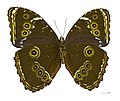
The morpho butterflies comprise many species of Neotropical butterfly under the genus Morpho. This genus includes more than 29 accepted species and 147 accepted subspecies, found mostly in South America, Mexico, and Central America. Morpho wingspans range from 7.5 cm (3.0 in) for M. rhodopteron to 20 cm (7.9 in) for M. hecuba, the imposing sunset morpho. The name morpho, meaning "changed" or "modified", is also an epithet. Blue morphos are severely threatened by the deforestation of tropical forests and habitat fragmentation. Humans provide a direct threat to this genus because their beauty attracts artists and collectors from all over the globe who wish to capture and display them. Aside from humans, birds like the jacamar and flycatcher are the adult butterfly’s natural predators.
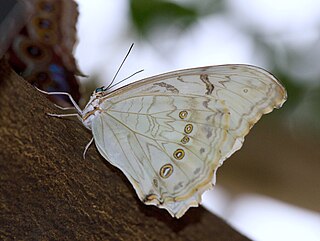
Morpho polyphemus, the white morpho or Polyphemus white morpho, is a white butterfly of Mexico and Central America, ranging as far south as Costa Rica. As suggested by its name, this is one of the relatively few Morphos that is white rather than blue. Some authorities include M. luna, which is also white, as a subspecies of M. polyphemus.

Danaus, commonly called tigers, milkweeds, monarchs, wanderers, and queens, is a genus of butterflies in the tiger butterfly tribe. They are found worldwide, including North America, South America, Africa, Asia, Indonesia and Australia. For other tigers see the genus, Parantica.

Morpho achilles, the Achilles morpho, blue-banded morpho, or banded blue morpho, is a Neotropical butterfly.

Morpho deidamia, the Deidamia morpho, is a Neotropical butterfly. It is found in Panama, Nicaragua, Costa Rica, Suriname, Bolivia, Venezuela, Colombia, Peru, Ecuador, and Brazil. It is a species group, which may be, or may not be several species. Many subspecies have been described.

Morpho aurora, the Aurora morpho, is a Neotropical butterfly found in Bolivia and Peru.
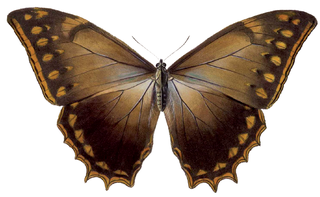
Morpho theseus, the Theseus morpho, is a Neotropical butterfly. It is found in Panama, Costa Rica, Mexico, Colombia, Peru, Ecuador, Venezuela, Honduras and Guatemala.
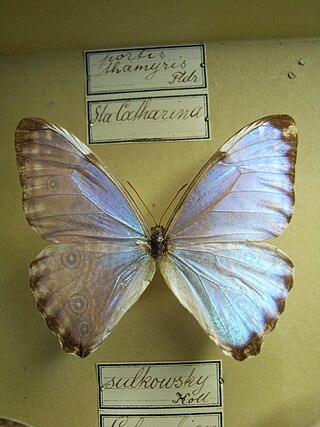
Morpho portis is a Neotropical butterfly. It is found in Brazil, Uruguay, Venezuela, Colombia, Peru, and Paraguay. Several subspecies and many forms have been described. The larvae feed on Gramineae.

Morpho adonis, the Adonis morpho, is a Neotropical butterfly. It is found in Venezuela, Suriname, French Guiana, Colombia, Ecuador, Brazil, and Peru. The wingspan ranges from 70 to 90 millimetres.

Morpho rhetenor, the Rhetenor blue morpho, is a Neotropical butterfly of the family Nymphalidae. It is found in Suriname, French Guiana, Brazil, Peru, Ecuador, Colombia, and Venezuela.

Morpho granadensis, the Granada morpho, is a Neotropical butterfly that is primarily found in Costa Rica. Several subspecies and many forms have been described. It is considered, by some authors, to be a subspecies of Morpho deidamia. Morpho granadensis is exceedingly rare in museum collections and the type specimen is from Costa Rica. The species is narrowly restricted in Costa Rica to band of tropical rain forest within 100 to 600 meters elevation along the Caribbean watershed of the Cordillera Central and the adjacent highlands. Several studies show that Morpho granadensis is half as abundant as other species like Morpho peleides.
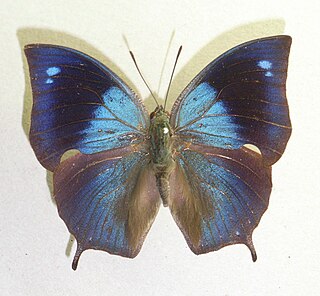
Memphis, described by Jacob Hübner in 1819, is a Neotropical nymphalid butterfly genus in the subfamily Charaxinae.
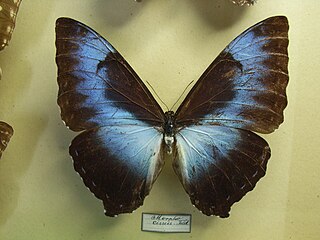
Morpho cisseis, the Cisseis morpho, is a large Neotropical butterfly found in the southern and western Amazon in Bolivia, Colombia, Peru, Ecuador, and Brazil. It includes several subspecies, but has itself sometimes been treated as a subspecies of the sunset morpho. Both are highly valued by collectors.

Morpho lympharis, the Lympharis morpho, is a Neotropical butterfly found in Peru and Bolivia.

Morpho thamyris, the Thamyris morpho, is a Neotropical butterfly found in Paraguay and Brazil.
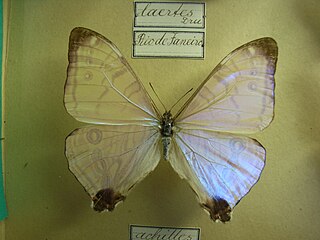
Morpho laertes, the white morpho or epistrophus white morpho, is a Neotropical butterfly found in Brazil, Uruguay, Paraguay, and Argentina. The white morpho is native to the Atlantic Forest, where they are distributed throughout a landscape of multiple species.

Morpho telemachus is a Neotropical butterfly.
Morpho uraneis is a Neotropical butterfly. It is found in Brazil and Ecuador.
Morpho niepelti is a Neotropical butterfly.












